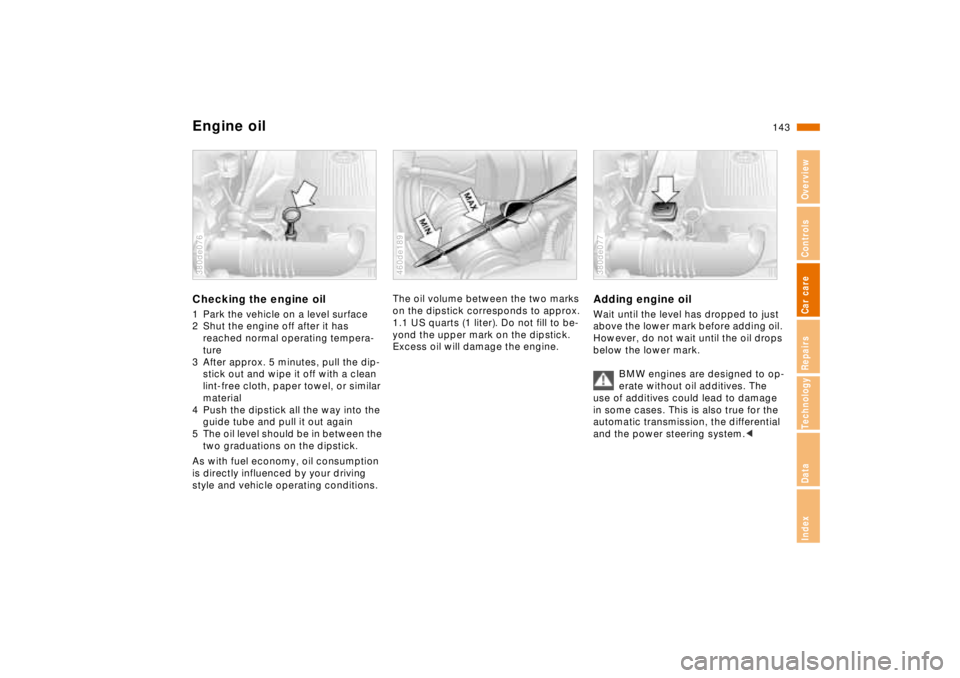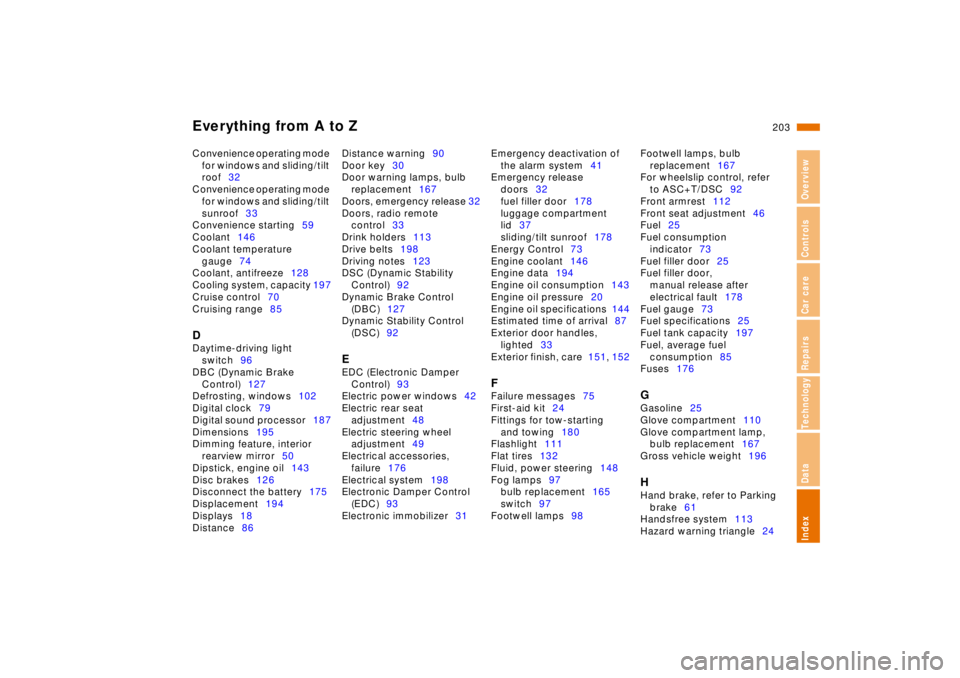Page 140 of 211
139n
RepairsIndexOverview Controls Car care Technology Data
Engine compartment – BMW 740i/L1 Brake fluid reservoir147
2 Power steering fluid reservoir/
Level control system148
3 Auxiliary terminal for jump
starting179
4 Engine oil dipstick143
5 Engine oil filler neck143
6 Coolant expansion tank146
7 Reservoir for headlamp
and windshield washer system142
8 Fuse box176
Page 142 of 211
141n
RepairsIndexOverview Controls Car care Technology Data
Engine compartment – BMW 750iL1 Brake fluid reservoir147
2 Power steering fluid reservoir/
Level control system148
3 Auxiliary terminal for jump
starting179
4 Engine oil filler neck143
5 Coolant expansion tank146
6 Engine oil dipstick143
7 Reservoir for headlamp
and windshield washer system142
8 Fuse box176
Page 144 of 211

143n
RepairsIndexOverview Controls Car care Technology Data
Engine oilChecking the engine oil1 Park the vehicle on a level surface
2 Shut the engine off after it has
reached normal operating tempera-
ture
3 After approx. 5 minutes, pull the dip-
stick out and wipe it off with a clean
lint-free cloth, paper towel, or similar
material
4 Push the dipstick all the way into the
guide tube and pull it out again
5 The oil level should be in between the
two graduations on the dipstick.
As with fuel economy, oil consumption
is directly influenced by your driving
style and vehicle operating conditions.380de076
The oil volume between the two marks
on the dipstick corresponds to approx.
1.1 US quarts (1 liter). Do not fill to be-
yond the upper mark on the dipstick.
Excess oil will damage the engine.460de189
Adding engine oilWait until the level has dropped to just
above the lower mark before adding oil.
However, do not wait until the oil drops
below the lower mark.
BMW engines are designed to op-
erate without oil additives. The
use of additives could lead to damage
in some cases. This is also true for the
automatic transmission, the differential
and the power steering system.< 380de077
Page 149 of 211
148n
Oil for power steering/Level control system
*
Vehicle Identification Number
Power steeringWith the engine off, unscrew the reser-
voir cap and remove the cap with dip-
stick. Then push the dipstick into the
reservoir again.
The fluid level should be in between the
marks on the dipstick.
Screw the reservoir cap back on.
Contact your BMW center if the fluid is
low, as only ATF may be used and spe-
cial knowledge is required for topping
up.380de078
Power steering/Level control
system
*
With the engine shut off, loosen the
knurled nut and remove the reservoir
cap.
With the vehicle empty, the fluid level
should be barely 0.2 in (5 mm) above
the screen bottom.
Correct the fluid level if required. Al-
ways use Pentosin CHF 11S.
Position the reservoir cap and tighten
the knurled nut. Make sure the cover is
properly seated.380de079
In the engine compartment, stamped on
the right-hand strut dome (arrow) and
on the upper edge of the instrument
panel on the left side.380de074
Page 204 of 211

RepairsIndexOverview Controls Car care Technology Data
Everything from A to Z
203n
Convenience operating mode
for windows and sliding/tilt
roof32
Convenience operating mode
for windows and sliding/tilt
sunroof33
Convenience starting59
Coolant146
Coolant temperature
gauge74
Coolant, antifreeze128
Cooling system, capacity 197
Cruise control70
Cruising range85
DDaytime-driving light
switch96
DBC (Dynamic Brake
Control)127
Defrosting, windows102
Digital clock79
Digital sound processor187
Dimensions195
Dimming feature, interior
rearview mirror50
Dipstick, engine oil143
Disc brakes126
Disconnect the battery175
Displacement194
Displays18
Distance86Distance warning90
Door key30
Door warning lamps, bulb
replacement167
Doors, emergency release 32
Doors, radio remote
control33
Drink holders113
Drive belts198
Driving notes123
DSC (Dynamic Stability
Control)92
Dynamic Brake Control
(DBC)127
Dynamic Stability Control
(DSC)92
EEDC (Electronic Damper
Control)93
Electric power windows42
Electric rear seat
adjustment48
Electric steering wheel
adjustment49
Electrical accessories,
failure176
Electrical system198
Electronic Damper Control
(EDC)93
Electronic immobilizer31Emergency deactivation of
the alarm system41
Emergency release
doors32
fuel filler door178
luggage compartment
lid37
sliding/tilt sunroof178
Energy Control73
Engine coolant146
Engine data194
Engine oil consumption143
Engine oil pressure20
Engine oil specifications144
Estimated time of arrival87
Exterior door handles,
lighted33
Exterior finish, care151, 152
FFailure messages75
First-aid kit24
Fittings for tow-starting
and towing180
Flashlight111
Flat tires132
Fluid, power steering148
Fog lamps97
bulb replacement165
switch97
Footwell lamps98Footwell lamps, bulb
replacement167
For wheelslip control, refer
to ASC+T/DSC92
Front armrest112
Front seat adjustment46
Fuel25
Fuel consumption
indicator73
Fuel filler door25
Fuel filler door,
manual release after
electrical fault178
Fuel gauge73
Fuel specifications25
Fuel tank capacity197
Fuel, average fuel
consumption85
Fuses176
GGasoline25
Glove compartment110
Glove compartment lamp,
bulb replacement167
Gross vehicle weight196HHand brake, refer to Parking
brake61
Handsfree system113
Hazard warning triangle24
Page 210 of 211
So that you will have important specifi-
cations available when you stop to re-
fuel, we recommend that you supple-
ment this table with data which apply to
your vehicle.
Fuel
For a description, refer to page 25
Engine oil For a description, refer to page 144
The space between the
two marks on the
dipstick corresponds to approx.
1.1 US quarts (1 liter). Designation
AKI: Minimum
AKI: For rated performance
AKI: For enhanced
performance
QualityTire inflation pressures For a description, refer to page 26Summer Winter
Front Rear Front Rear
4 persons
5 persons or 4 plus luggageRefueling